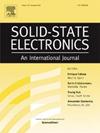Simulation and experimental Demonstration on A retrograde drift LDMOS
IF 1.4
4区 物理与天体物理
Q3 ENGINEERING, ELECTRICAL & ELECTRONIC
引用次数: 0
Abstract
In this article, an RD (Retrograde drift) LDMOS (Lateral double diffused metal oxide semiconductor) device is introduced. The drift region in this proposed device is trapezoidal in shape and gradually decreases from top to bottom in doping concentration, called “retrograde drift.” Simulations indicate that this RD device has an 11.7% lower electric field peak value, 6.2% lower potential under the poly gate, 32.1% higher current width in the drift region, and 10.5% lower impact gen rate at the corner of FP (Field plate) as well. A series of devices have been fabricated using a photoresist treatment process. Compared with the conventional BD (box-shape drift) device, the RD device’s (Breakdown voltage)- (on-resistance) FOM (Figure of merit) performance is improved by 30.9%, and the (Gate-drain charge)- FOM character is improved by 42.1%. Moreover, the RD device owns better HCI (Hot carrier injection) performance on both degradation and (Threshold voltage) degradation.
一种逆行漂移LDMOS的仿真与实验论证
介绍了一种逆行漂移(RD)双扩散金属氧化物半导体(LDMOS)器件。该装置的漂移区域呈梯形,随着掺杂浓度的增加,从上到下逐渐减小,称为“逆行漂移”。仿真结果表明,该器件的电场峰值降低了11.7%,多栅极下电位降低了6.2%,漂移区电流宽度提高了32.1%,FP(场板)角处的冲击产生率降低了10.5%。利用光刻胶处理工艺制备了一系列器件。与传统的BD(箱形漂移)器件相比,RD器件的BV(击穿电压)-Ron,sp(导通电阻)FOM性能提高了30.9%,Qgd(栅漏电荷)-Ron,sp FOM性能提高了42.1%。此外,该RD器件在Ron、sp降解和VT降解上都具有更好的HCI(热载流子注入)性能。
本文章由计算机程序翻译,如有差异,请以英文原文为准。
求助全文
约1分钟内获得全文
求助全文
来源期刊

Solid-state Electronics
物理-工程:电子与电气
CiteScore
3.00
自引率
5.90%
发文量
212
审稿时长
3 months
期刊介绍:
It is the aim of this journal to bring together in one publication outstanding papers reporting new and original work in the following areas: (1) applications of solid-state physics and technology to electronics and optoelectronics, including theory and device design; (2) optical, electrical, morphological characterization techniques and parameter extraction of devices; (3) fabrication of semiconductor devices, and also device-related materials growth, measurement and evaluation; (4) the physics and modeling of submicron and nanoscale microelectronic and optoelectronic devices, including processing, measurement, and performance evaluation; (5) applications of numerical methods to the modeling and simulation of solid-state devices and processes; and (6) nanoscale electronic and optoelectronic devices, photovoltaics, sensors, and MEMS based on semiconductor and alternative electronic materials; (7) synthesis and electrooptical properties of materials for novel devices.
 求助内容:
求助内容: 应助结果提醒方式:
应助结果提醒方式:


